What is the danger of low hemoglobin and how buckwheat increases it
Constant fatigue, deterioration of the condition of the skin, nails and hair, causeless weakness: these are all symptoms of anemia (or, in simple terms, anemia). One of the most popular foods that contains iron and raises hemoglobin is buckwheat.
You will find out how it affects blood counts and how to take it correctly in our article.
The content of the article
What is the danger of low hemoglobin
Hemoglobin is a protein that is part of red blood cells (erythrocytes), which are responsible for oxygen supply of tissues and organs.
When the number of red blood cells decreases, the person develops anemia. The body stops receiving the required amount of oxygen, the work of all systems is disrupted.
In an adult
Decreased hemoglobin is most often observed for the following reasons:
- Vegetarianism. Since the diet is based on plant foods, the iron received is not enough to maintain normal hemoglobin levels.
- Intestinal parasites. They intercept all incoming trace elements and vitamins, which also affects the development of anemia.
- Various problems with the gastrointestinal tract inhibit the absorption of iron.
- Severe blood loss caused by injuries, surgical intervention, menstruation, bleeding that occurs during childbirth and abortion, as well as donation of blood and its components.
- Pregnancy and breastfeeding. Iron, which is contained in the blood, is necessary not only for the mother, but also for the child for full development. By the end of pregnancy, iron stores are noticeably depleted, therefore, for full recovery, another 2-3 years are needed, which fall on the period of breastfeeding.
Iron deficiency is manifested:
- deterioration of the condition of the skin, nails and hair;
- dizziness and fainting;
- numbness of hands and feet, causeless weakness;
- memory impairment;
- slowing down of nervous reactions;
- problems with the heart and blood vessels;
- decreased immunity.
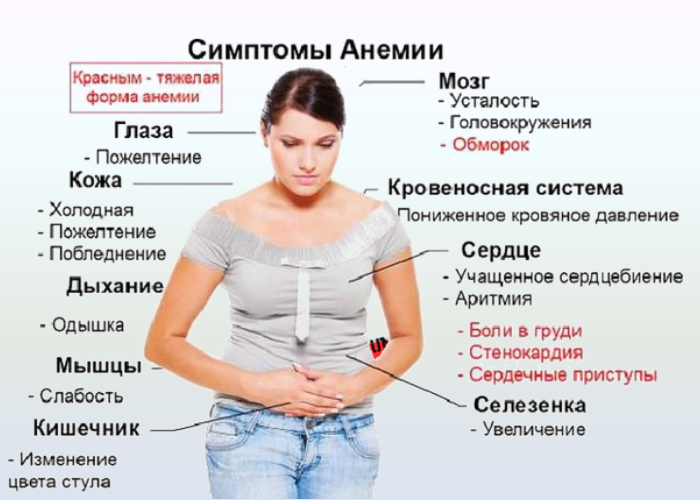
In pregnant women
Low hemoglobin levels are common during pregnancy. The fact is that during this period the need for iron increases significantly, but it does not always enter the body in the required amount.
Anemia symptoms:
- weakness;
- brittle nails;
- hair problems;
- pallor;
- change in taste;
- addiction to unusual smells;
- dyspnea;
- chest pain or heart palpitations.
With low hemoglobin in the mother's body, serious changes occur:
- immunity decreases;
- blood clotting is disturbed;
- the risk of complications during pregnancy increases;
- placental insufficiency develops;
- increased toxicosis;
- fetal hypoxia develops;
- labor activity weakens;
- the risk of premature birth increases;
- bleeding increases during or after childbirth.
Although low hemoglobin affects the mother's condition, it also affects the baby. So, newborns gain weight worse.
Reference. A child under 2 years old is 70% provided with iron from the mother.
In children
Often, a child has a low hemoglobin level. The symptoms are as follows:
- dizziness;
- cardiopalmus;
- fainting;
- apathy;
- lethargy;
- headaches;
- breathing disorder;
- depression;
- dryness and pallor of the skin;
- brittle nails;
- thinning and hair loss.
Among the causes of anemia in a child:
- malnutrition;
- iron deficiency in the mother during and after pregnancy;
- hereditary diseases;
- bone marrow pathology;
- problems with the gastrointestinal tract;
- infectious or parasitic diseases.
The lack of hemoglobin negatively affects the immunity, physical and mental development of the child.
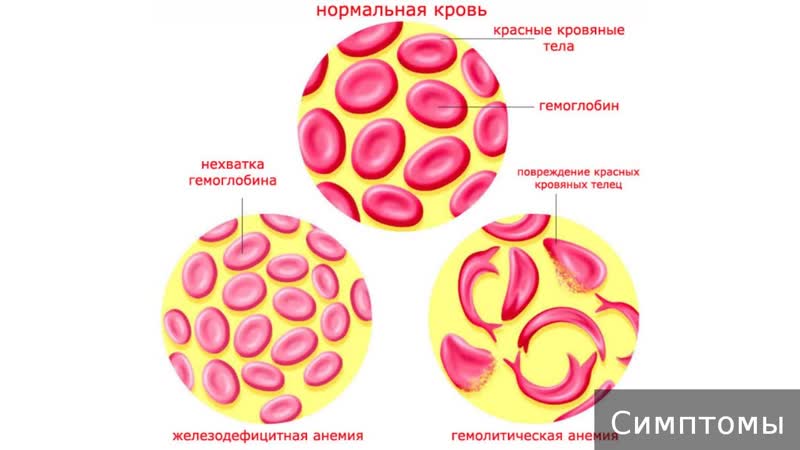
In the elderly
Older people are not as often anemic as people think. Their symptoms, as a rule, are mild, which further complicates correct diagnosis. You can accurately determine the level of hemoglobin by passing a complete blood count.
How buckwheat affects hemoglobin levels
Many are interested in whether buckwheat increases hemoglobin or not. Yes, it does, and this is not the only beneficial effect of the product.
The beneficial effect of buckwheat on the body is manifested as follows:
- Iron, folic and ascorbic acids stimulate the formation of red blood cells, improve complexion, skin, hair, nails and overall well-being.
- Potassium maintains normal blood pressure.
- Rutin thickens the walls of blood vessels, improves blood circulation in general.
How to raise hemoglobin with buckwheat
With a low hemoglobin, doctors recommend more often include buckwheat in any form in the diet. It is a hypoallergenic product, so there is no health risk when consuming it.
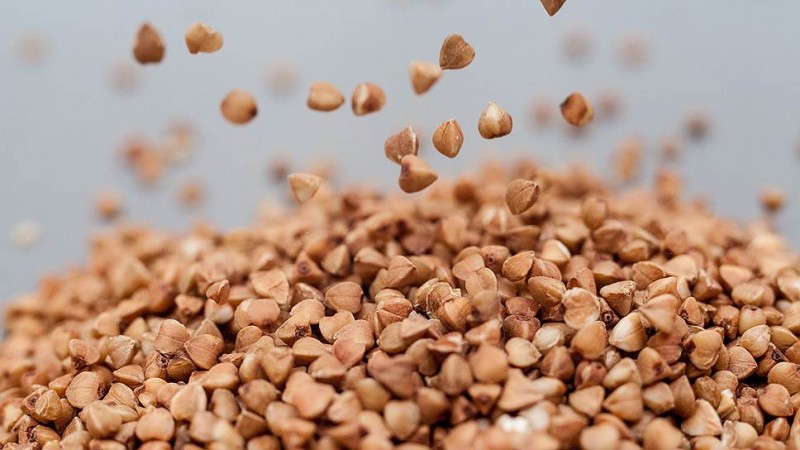
It is most useful to use buckwheat for food with anemia:
- green;
- ground;
- in combination with kefir, honey and walnuts.
Thanks to this, not only the level of hemoglobin in the blood rises, but the entire cardiovascular system is strengthened. But eating one buckwheat will not be enough in the fight against anemia.
Other recommendations:
- Drink plenty of clean water.
- Don't give in to stress.
- Spend time outdoors.
- To refuse from bad habits.
- Do sport.
- Live in favorable environmental conditions.
Recipes to increase hemoglobin with buckwheat
Buckwheat is one of the most popular and healthy cereals. Most often, it is simply boiled, but there are many other ways to prepare it.
With ground buckwheat
To increase hemoglobin, it is recommended to use ground buckwheat. It is much easier for the body to absorb, and porridge from it are similar in consistency to puree.
Recipe:
- Rinse the groats and dry in a hot frying pan.
- Then grind it yourself - by hand or using a coffee grinder, meat grinder, etc.
- Pour dry ground buckwheat with warm clean water. Insist until porridge is formed.
It is recommended to eat for an afternoon snack or replace all snacks during the day. Thanks to the resulting consistency, it is suitable for children's diets and for the elderly.
Buckwheat with kefir
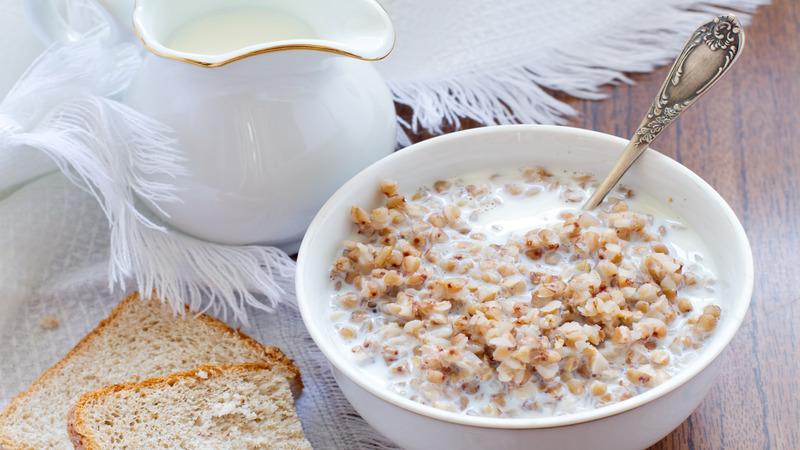
One of the simplest recipes is buckwheat with kefir. For this you need:
- buckwheat - 5 tbsp. l .;
- low-fat kefir - 300 ml.
Preparation:
- Rinse the groats.
- Pour buckwheat with kefir.
- Leave in the refrigerator for 6 to 8 hours.
It is recommended to consume on an empty stomach.
Buckwheat with honey and nuts
Buckwheat, walnuts and honey contain many nutrients. They strengthen the body and increase the level of hemoglobin in the blood.
Ingredients:
- unground - 1 kg (preferably green);
- shelled walnuts - 1 kg;
- honey - 700 g.
Preparation:
- Boil buckwheat porridge so that it is crumbly. The process takes no more than 20 minutes.
- Add honey and crushed walnuts.
- To stir thoroughly.
Recommended to be consumed warm and in the morning.
Other
Raw green buckwheat is no less useful. Its main difference from the usual one is that green buckwheat has not been heat-treated, which means that all useful substances are completely preserved in it.
It is prepared in the same way as brown cereal, or eaten sprouted in salads.
To germinate green buckwheat at home, you will need:
- green buckwheat - portion size is calculated individually;
- filtered water.
Preparation:
- Rinse the seeds.
- Place the grains in a bowl where they will germinate.
- In 1 st. buckwheat pour 3 tbsp. water.
- Leave to swell for 3 hours.
- Rinse the grains again.
- Spread out in a thin layer and cover with cheesecloth.
- Put the container in a warm place for a day.
The optimum sprout size for human consumption is about 2-3 mm. To stop them growing, refrigerate them for a while.
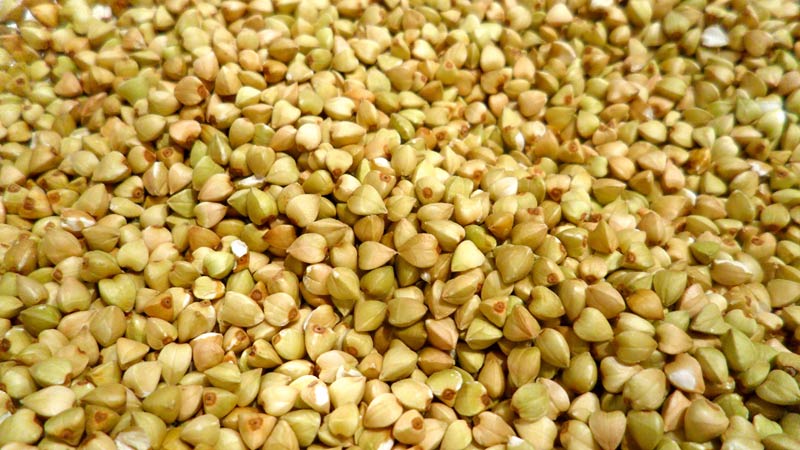
Possible harm and contraindications
Buckwheat is not recommended for use when:
- Diseases of the gastrointestinal tract. Poorly steamed or boiled buckwheat is poorly digested.
- Hypotension. Magnesium, which is contained in buckwheat, relaxes the walls of blood vessels so much that it leads to a sharp drop in pressure.
- Individual intolerance.
Tips & Tricks
To prevent anemia, doctors recommend:
- Eat right, include in the daily diet foods containing iron (meat, herbs, fruits and vegetables).
- Spend more time outdoors.
- Take a blood test once a year.
- Consult a specialist in the event of acute infectious and viral diseases.
- Undergo a medical examination annually. Anemia is caused by other health problems.
- Planning a pregnancy. This approach will minimize all possible risks to the health of the mother and baby, which also include anemia.
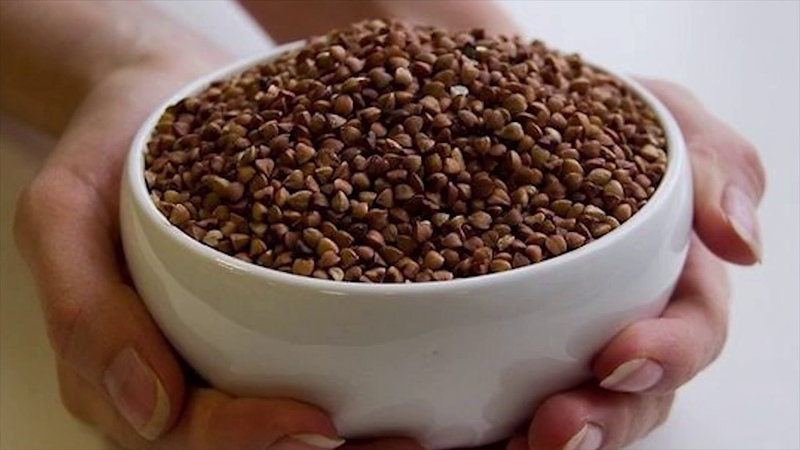
Here's what doctors say about treating anemia.
Alekseeva I.A., hematologist: “If with the help of food products, for example, buckwheat, it is impossible to raise hemoglobin to a normal level, then it is better to immediately contact a specialist. He will already prescribe iron supplements. "
Fedorov E.V., hematologist: “In case of low hemoglobin, it is better to see a doctor right away. And if the degree of anemia is insignificant, then yes, you will simply be advised to eat as many foods as possible that contain a sufficient amount of iron. Buckwheat is a great option for raising hemoglobin. But it is unacceptable to diagnose yourself on your own, examination by a specialist is obligatory. "
Conclusion
Eating buckwheat is a simple and effective way to increase hemoglobin levels. The presence of a large amount of useful and nutrients in it will help improve health.
But remember that with a reduced hemoglobin, you first need to see a doctor. He will prescribe an examination, identify the causes of the disease and prescribe appropriate treatment, including diet food, which will most likely include buckwheat.